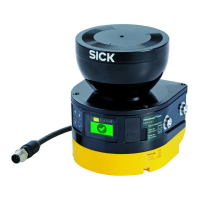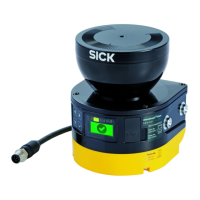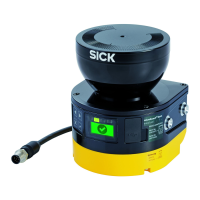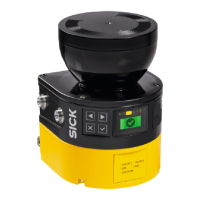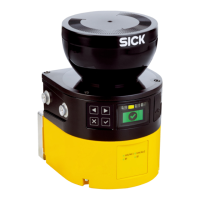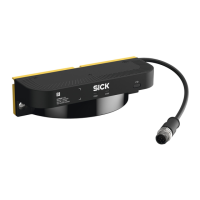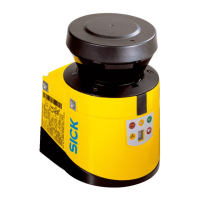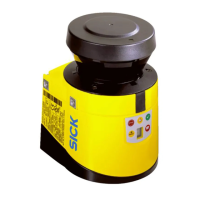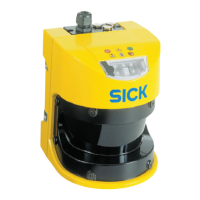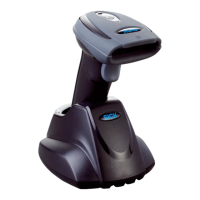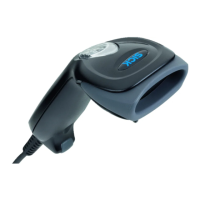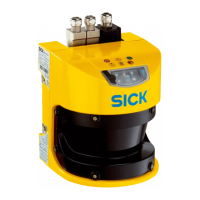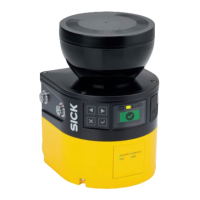
Do you have a question about the SICK microScan3 Pro I/O and is the answer not in the manual?
| Scanning angle | 275° |
|---|---|
| Number of fields | 128 |
| Dimensions | 102 mm x 152 mm x 106 mm |
| Number of safety outputs | 2 |
| Number of OSSD outputs | 2 |
| Scanning range | 5.5 m |
| Protective field range | 5.5 m |
| Resolution | 30 mm |
| Number of monitoring cases | 128 |
| Response time | 60 ms |
| Interfaces | Ethernet, USB |
| Operating temperature | +50 °C |
| Protection class | IP65 |
| Supply voltage | 24 V DC |
| Storage temperature | +70°C |
| Operating voltage | 24 V DC (16.8 V DC ... 28.8 V DC) |
| Housing material | Plastic |
| Connection type | Male connector |
Explains the purpose of these operating instructions for the safety laser scanner.
Defines the products and document identification covered by these instructions.
Identifies specific chapters for different user groups of the safety laser scanner.
Provides details on where to find additional product information online.
Details the symbols and conventions used throughout the document for clarity.
Provides overarching safety information, including product integration and laser class warnings.
Specifies the applications for which the safety laser scanner is suitable and warns against misuse.
Details dangerous situations arising from incorrect use or non-observance of protective measures.
Addresses the importance of a comprehensive cybersecurity concept for product protection.
Outlines the necessary expertise for personnel involved in product installation and operation.
Provides a visual guide to the safety laser scanner's components and their locations.
Explains the principle of operation and how the safety laser scanner detects objects.
Details key features such as scan cycle time, resolution, and performance packages.
Highlights distinguishing features of different product variants.
Lists and describes the available connectors for system integration and communication.
Explains the function and importance of the system plug for device configuration.
Defines various types of fields like protective, warning, and contour fields.
Describes the function of the protective field in safeguarding hazardous areas.
Explains the use of reference contours for detecting environmental changes.
Details how contour detection fields monitor environmental contours for deviations.
Covers the function of collision protection fields for industrial trucks in narrow aisles.
Describes warning fields for non-safety applications like approach detection.
Explains that a field set consists of one or more fields monitored simultaneously.
Defines a monitoring case as a signal for machine status, activating field sets.
Covers the capability to monitor multiple field sets in one monitoring case.
Illustrates practical applications like hazardous area and point protection.
Explains detecting people in defined areas for machine safety.
Details detecting approach close to a hazardous point for safety.
Describes detecting whole body passage through a protective field for access control.
Covers protection for AGVs, cranes, and forklifts against moving vehicles.
Details safety considerations for the machine manufacturer regarding protective devices.
Outlines safety responsibilities for the machine operator concerning protective devices.
Provides crucial information and prerequisites for mounting the safety laser scanner.
Discusses how external factors can affect the scanner and how to mitigate them.
Details methods to prevent access to undetected areas around the scanner.
Explains the importance of response time for scanner positioning and field sizing.
Covers the configuration of reference contour fields for monitoring environmental contours.
Details how protective fields must be larger than openings for hazardous point protection.
Specifies requirements for protective fields relative to openings for access protection.
Addresses timing considerations for switching between monitoring cases to ensure detection.
Describes stationary applications for hazardous area protection using a horizontal scan plane.
Explains how to design protective fields for minimum distance and detection.
Details the calculation of minimum distances based on standards like ISO 13855.
Discusses the impact of scan plane height on leg detection and required resolution.
Provides a formula to calculate required resolution based on protective field height.
Recommends planning space between protective fields and walls for availability.
Covers stationary applications in vertical operation for hazardous point protection.
Details stationary applications for access protection with a vertical scan plane.
Explains protective field design for reliable detection in access protection scenarios.
Describes minimum distance calculation for orthogonal approaches in access protection.
Covers horizontal scan plane use in mobile applications for hazardous area protection.
Details designing protective field length for stopping vehicles before collision.
Explains the supplement for ground clearance in mobile applications.
Provides an example calculation for protective field length including various supplements.
Defines stopping distance, including vehicle braking and scanner response times.
Covers designing protective field width considering vehicle dimensions and turning.
Details the supplement for reflection-based errors in narrow aisle applications.
Explains the ZF supplement for vehicle ground clearance in width calculations.
Provides an example calculation for protective field width with supplements.
Specifies requirements for scan plane height for reliable detection of lying people.
Outlines requirements for using industrial trucks in narrow aisles for protection.
Details designing protective fields for narrow aisles, considering person detection.
Explains protective field length calculation for stopping industrial trucks under all conditions.
Covers reliable collision protection for oncoming industrial trucks in narrow aisles.
Specifies scan plane height prerequisites for collision protection in narrow aisles.
Details prerequisites for correctly mounting reference targets for collision protection.
Specifies distance requirements for collision protection fields from racks.
Provides a formula to calculate minimum distance to structures considering yaw angle.
Details calculation of collision protection field length for timely braking of trucks.
Provides information on electrical integration requirements for safe device operation.
Discusses measures to avoid electromagnetic interference and grounding concepts.
Details safety requirements for the device's power supply unit and electrical protection.
Explains the use of the USB connection for temporary configuration and diagnostics.
Covers integration of safety laser scanners with local outputs into machine controllers.
Details how control inputs are used for switching monitoring cases and machine status.
Explains static control inputs for monitoring case switching using complementary or 1-of-n evaluation.
Describes dynamic control inputs for receiving speed information from incremental encoders.
Covers the use of universal inputs and outputs for various device functions.
Explains EFI-pro as an Ethernet-based network for safety-related data communication.
Details the function of restart interlocks to prevent automatic machine startup.
Explains EDM for monitoring the status of downstream contactors.
Provides information on integrating the safety laser scanner into a network.
Lists network services and their associated ports used for communication.
Details safety considerations and addressing for network integration.
Explains how cyclic data transmission in EFI-pro networks is done via data sets called assemblies.
Describes combining multiple safety laser scanners into a host-guest group for logical connection.
Outlines the requirements for testing the protective device during commissioning and regularly.
Details minimum requirements and procedures for initial and situation-specific thorough checks.
Explains the purpose of regular tests to detect defects and ensure necessary protection.
Provides guidance and recommendations for conducting various tests.
Describes the procedure for checking the primary function of the protective device.
Explains how to examine the protected area and detection capability during checks.
Details how to test the functionality of contour detection fields.
Outlines steps to test if each collision protection field fulfills its intended function.
Recommends a procedure for visually inspecting the machine and protective device.
Covers safety warnings and requirements related to mounting the safety laser scanner.
Provides an approach for checking components during unpacking.
Details the available options and essential instructions for mounting the scanner.
Explains how to change the position of the system plug if necessary.
Describes how to mount the scanner directly using threaded holes on the back.
Covers safety requirements for electrical installation and integration into the machine control.
Provides an overview of the system connectors and their functions on the microScan3 Pro I/O.
Details system connectors and plug assignments for the microScan3 Pro I/O.
Provides detailed pin assignments for the various connectors on the device.
Details the pin assignment for the voltage supply connector (M12, 4-pin, A-coded).
Explains the alternative connection method for functional earth.
Describes Ethernet connections for EFI-pro, data output, configuration, and diagnostics.
Details the pin assignment for local inputs and outputs on the 17-pin connector.
Covers the pin assignment for dynamic control inputs used with incremental encoders.
Details the pin assignment for local inputs and outputs on the second 17-pin connector.
States that the device is not configured upon delivery.
Introduces the Safety Designer software for configuring the safety laser scanner.
Provides a step-by-step guide for installing the Safety Designer software.
Explains how to create and save device configurations within projects.
Describes how to save configuration verification status within a project.
Provides an overview of the Safety Designer software's user interface elements.
Details user groups, their passwords, and authorization levels for device access.
Refers to Safety Designer operating instructions for network functionality.
Presents an overview of the Safety Designer's configuration interface and device status.
Explains how to identify and match device and software functional scopes.
Covers network configuration, specifically EFI-pro IP settings.
Details network settings for EFI-pro, including IP address configuration.
Describes how to read values from the device or transmit project values to the device.
Explains how to read and adopt configured values from the device into the project.
Allows optional entry of names and information to identify application, project, and devices.
Optional field to help users find contact information for the application.
Allows uploading an image to quickly identify the application, saved as a thumbnail.
Provides a field for a description to enhance understanding of application context.
Covers protocol-specific settings, starting with EFI-pro.
Details the EFI-pro protocol settings, specifically the Safety Network Number (SNN).
Displays data flow in a host-guest group graphically, showing connections and assemblies.
Allows editing fields for connections, like name and requested packet interval (RPI).
Allows selection of the application type, such as mobile or stationary.
Guides the selection of application type based on scanner usage (mobile or stationary).
Enables selection of a display language for operator understanding.
Allows rotation of the display orientation by 180° if the scanner is mounted upside down.
Covers the definition of the scan plane and parameters for monitoring planes.
Allows configuration of name, task, object resolution, and multiple sampling for monitoring planes.
Allows assigning a descriptive name to monitoring planes for identification.
Defines safety tasks based on approach direction and required object resolution.
Enables monitoring of contours for detecting environmental changes, using a reference contour field.
Defines the minimum object size for reliable detection, with available resolution options.
Explains multiple sampling for object detection and its impact on response time and availability.
Covers adjusting multiple sampling for quick detection during monitoring case switches.
Allows specifying different multiple sampling rates after an object is no longer detected.
Details configuration parameters for the safety laser scanner, including scan cycle time.
Explains how scan cycle time affects response time and protective field range.
Describes settings to prevent mutual interference between nearby safety laser scanners.
Covers drawing and configuring reference contour fields based on project planning.
Provides instructions on how to draw reference contour fields using the field editor.
Details configuring multiple sampling and object resolution for individual fields.
Explains how to define positive and negative tolerance bands for contours.
Allows assigning a unique name to each field set for identification.
Covers configuring field sets using the field editor, depending on the scanner variant.
Guides users on drawing fields and masked areas within the field editor.
Explains how Safety Designer displays different field types in distinct colors.
Details the process of creating fields and field sets, including naming and ordering.
Covers assigning names and selecting field types, adjusting sampling and resolution.
Details configuring multiple sampling and object resolution for individual fields.
Explains how to define positive and negative tolerance bands for contours.
Allows assigning a unique name to each field set for identification.
Explains how to create reusable field set templates for common combinations of fields.
Covers importing and exporting field sets and fields between projects.
Allows selecting a background image for the field editor, like a machine plan view.
Allows editing settings for the field editor, including field calculation methods.
Specifies whether fields are calculated manually or automatically after drawing.
Allows determining whether the reference contour field is displayed.
Covers using Cartesian or polar coordinates and selecting colors for the drawing area.
Explains how to edit fields using coordinates, showing a dialog for rectangles.
Details drawing masked areas to represent areas that cannot be monitored due to shadows.
Explains drawing objects that limit the field of view as masked areas.
Allows Safety Designer to suggest protective or warning fields based on surrounding contours.
Warns that field proposals do not replace minimum distance calculations.
Covers deleting or refining existing shapes based on surrounding contours.
Describes methods for using distance values to draw fields.
Explains teach-in types like 'only allow reduction' and 'allow expansion'.
Allows specifying proposed fields drawn smaller than measured contours for distance from walls.
Explains reducing points and simplifying lines in proposed contours.
Provides an overview of signal inputs and outputs and their configuration in Safety Designer.
Specifies if the same source is used for all inputs.
Details specifying the source for switching between monitoring cases.
Specifies the source used for speed and tolerated deviation between two signals.
Allows specifying the source for restarting the device, sleep mode, or pausing event history.
Configures device behavior when secure communication is reestablished after an interruption.
Shows which local outputs are configured in Safety Designer.
Sets whether guest device monitoring results are used to switch local outputs.
Defines whether the internal restart interlock for network outputs is used.
Safety Designer displays available network outputs.
Guides assigning signals to the safety laser scanner connection in the Inputs and outputs dialog.
Details output signals like OSSD pairs, contamination, errors, and reset status.
Signals optics cover contamination status, indicating warnings or errors.
Signals device or application errors, potentially requiring device restart.
Signals that a reset is possible, indicating restart interlock status.
Indicates the status of the active field, lighting up if an object is detected.
Signals reset possibility and flashing if restart interlock is triggered.
Details input types, including static control inputs for monitoring case switching.
Describes static control inputs for monitoring case switching based on machine controller signals.
Explains dynamic control inputs for speed-dependent switching using incremental encoders.
Details EDM signals from auxiliary contacts of positively guided contactors.
Describes signals from a reset pushbutton for manual restart interlock reset.
Describes signals from a pushbutton to activate sleep mode.
Describes signals from a pushbutton to completely restart the device.
Describes signals from a pushbutton to stop event history recording.
Covers additional settings for signals like restart interlock and EDM.
Details options for restart interlock behavior for OSSDs (immediate, reset required, automatic).
Explains the input configuration requirement for external device monitoring (EDM).
Provides an overview of defining monitoring cases, input conditions, and assigning field sets.
Covers settings for monitoring case tables, including naming and input delay.
Allows entering a descriptive name for monitoring case tables.
Explains how to select static control inputs for monitoring case switching.
Allows selecting an input delay for static control inputs to handle switch bounce times.
Activates the option to use speed for monitoring case switching or as an additional condition.
Specifies the order in which monitoring cases can be called, including subsequent cases.
Defines individually which monitoring cases may follow each monitoring case.
Covers support for multiple simultaneous monitoring case tables for flexible switching.
Covers settings for individual monitoring cases, including name and sleep mode.
Allows entering a descriptive name for monitoring cases.
Activates sleep mode for the safety laser scanner when input conditions are met.
Allows choosing input conditions for activating specific monitoring cases.
Defines speed ranges or limits for activating monitoring cases.
Allows creating cut-off paths and defining outputs switched by them.
Details creating cut-off paths and assigning names and OSSD pairs.
Explains how to assign an OSSD pair to a cut-off path.
Covers selecting the cut-off path number for assembly assignment.
Details assigning universal outputs to cut-off paths.
Defines restart behavior for network outputs in the Inputs and outputs window.
Guides on assigning created field sets to monitoring cases.
Explains how to remove a field set assignment from a monitoring case.
Details cut-off behaviors like Always ON (safe/non-safe) and Always OFF.
Allows visualization of the configured results in a simulation environment.
Lists simulation components like OSSD pair status and cut-off path display.
Enables defining which data from the scanner is output via UDP or TCP/IP.
Configures data output modes: deactivated, on request, or continuous.
Allows selecting specific data content for output, like device status or object detection.
Defines the range for measurement data and field detection output.
Covers transferring the device configuration, warning about overwriting existing data.
Details checks to ensure the configuration is verified before automatic startup.
Explains how to confirm the configuration complies with safety functions and risk assessment.
Step-by-step guide for transmitting and verifying the device configuration.
Describes manual start and stop of the safety function, and operational requirements.
Explains how to create, view, and save reports showing device settings and data.
Details how Safety Designer creates and updates reports.
Guides on composing report contents individually by selecting report settings.
Covers device restart options for troubleshooting and resolving problems.
Explains different device restart methods: safety function, connections, or complete restart.
Describes the fastest restart type, maintaining communication after serious faults.
Details re-establishing device function and communication after serious faults.
Explains complete device restart behavior similar to power cycling.
Covers removing links to controllers for EtherNet/IP connections.
Explains how to reset safety function and communication settings to factory defaults.
Details assigning, changing, and resetting user passwords for device access management.
Provides steps for establishing a connection and changing user passwords.
Outlines the procedure to request and reset administrator passwords via SICK support.
Covers activating or deactivating interfaces and selected functions as needed.
Describes managing access by activating/deactivating interfaces and functions.
Allows activating/deactivating functions and selecting default settings based on device capabilities.
Addresses how settings stored in system connectors are handled with older or replacement devices.
Allows activating/deactivating functions and selecting default settings based on device capabilities.
Specifies if the device can be restarted using the pushbuttons on the display.
Details deactivating the USB interface to restrict access, maintaining existing connections.
Allows activation or deactivation of the EFI-pro network connection for Port 1.
Allows activation or deactivation of the EFI-pro network connection for Port 2.
Covers activating/deactivating CoLa2 for device configuration and diagnostics via network.
Explains the necessity of calibrating the optics cover after replacement for accurate measurement.
Covers critical safety warnings before commissioning and during initial operation.
Details options for precisely aligning the safety laser scanner using mounting kit 2.
Describes the start-up procedure, internal tests, and status LED indications.
Ensures hazardous area monitoring and prevention of attempted access after changes.
Highlights safety precautions for maintenance, alignment, and fault diagnosis by qualified personnel.
Ensures hazardous area monitoring and prevention of attempted access through tests.
Provides an overview of the device's status LEDs and display indicators.
Details the function, color, and meaning of the status LEDs.
Explains the purpose of network LEDs for diagnostic purposes only.
Lists LED statuses, relevance, and troubleshooting steps for network interfaces.
Details EFI-pro LEDs for network status and module status relevance.
Describes how the display shows current information about the scanner's status.
Warns against improper work on the product and emphasizes safety during maintenance.
Provides instructions for regular cleaning of the optics cover to maintain detection capability.
Details the process for replacing a scratched or damaged optics cover, including calibration.
Covers procedures for replacing a damaged or defective safety laser scanner.
Explains how to replace the scanner while reusing the existing bracket and system plug.
Details the steps for completely replacing the safety laser scanner, including configuration and commissioning.
Provides instructions for replacing a damaged or defective system plug.
Ensures hazardous area monitoring and prevention of attempted access through regular checks.
Covers safety warnings for troubleshooting, emphasizing machine shutdown and securing.
Explains how to use the device's pushbuttons to navigate menus for diagnostics.
Lists the menu areas accessible from the device, including device info and diagnostics.
Provides steps for navigating the device menu using the pushbuttons.
Details information available in the device info area, such as hardware and configuration.
Guides on checking for external light sources and analyzing intrusions and messages.
Lists options available in the device restart area.
Lists options available in the settings area, such as display brightness.
Explains how faults are indicated on the display with symbols, fault types, and codes.
Lists available diagnostics tools in Safety Designer, such as data recorder and event history.
Explains using the data recorder to record device signals and check typical applications.
Describes how the event history displays information about the most recently stored events.
Details the types of events stored in the scanner's memory.
Explains data sources for events: read from device, load file, or store data.
Shows a graphical overview of object detections leading to safety output switching.
Provides detailed information about events that caused safety output switching.
Shows how often object detections occur and their durations.
Explains how to view and store events like faults, warnings, and information.
Describes how Safety Designer displays information on supported assemblies.
Provides guidance on proper disposal of unusable devices according to regulations.
Lists device variants, protective field ranges, system plug positions, and type codes.
Explains how to identify device functionality levels using version numbers.
Details how to read the functional scope of the device from labels or software.
Describes how device revision statuses are identified by revision numbers.
Provides detailed technical data for the microScan3 Pro I/O.
Lists features including protective field range, scanning ranges, and resolution.
Specifies safety-related parameters like integrity level, category, and performance level.
Details interface types, including OSSD pairs, voltage supply, and local I/Os.
Provides dimensions, weight, housing material, and optics cover specifications.
Lists enclosure rating, ambient light immunity, operating temperature, and humidity.
Includes miscellaneous data like wavelength, detectable remission, and light spot size.
Defines protective device response time and factors influencing it.
Provides formulas and tables for calculating response time based on scan cycle time and other parameters.
Explains response time calculation considering host-guest group transmission and processing times.
Describes how the safety laser scanner tests active OSSD pairs for voltage-free status.
Details protective field range based on resolution and scan cycle time for different variants.
Provides tables showing protective field range for various resolutions and scan cycle times.
States that the scanning range for reference contour fields is the same as the protective field range.
States that the scanning range for contour detection fields is the same as the protective field range.
Illustrates scanning range and object size requirements for non-safety warning fields.
Covers data exchange via the network, focusing on assemblies and available data.
Explains assemblies as data sets for cyclic data transmission in EFI-pro networks.
Lists available data points for device inputs (control outputs) and their safety implications.
Details data inputs for the device, including monitoring case switching and safe speed.
Lists output data from the device, like application errors and contamination status.
Details Assembly 103 for device input and control output, including data and update cycle.
Details Assembly 104 for device input and controller output, including control inputs.
Details Assembly 105 for device input and control output, including safe speed information.
Details Assemblies 106-108 for guest device input and output, enabling local output switching.
Details Assembly 110 for device output and control input, including status and error signals.
Details Assembly 113 for device output and control input, including status and error signals.
Details Assembly 114 for guest device output and input, enabling local input usage.
Details Assembly 115 for device output and controller input, covering various status signals.
Details Assembly 120 for non-safety related output/input, used for automation and diagnostics.
Details Assembly 121 for non-safety related output/input, used for automation and diagnostics.
Provides detailed dimensional drawings of the safety laser scanner.
Lists the items included in the scope of delivery for the safety laser scanner.
Provides ordering data, type codes, and part numbers for different scanner variants.
Lists spare parts for the safety laser scanner, including part numbers and protective field ranges.
Provides part numbers and connection types for the system plug.
Lists additional spare parts like optics covers and cover plates with their part numbers.
Lists ordering information for various mounting kits and brackets.
Provides ordering information for the alignment aid accessory.
Lists ordering information for cleaning agents like anti-static plastic cleaner.
Provides ordering information for test rods of different sizes and a test rod holder.
Lists additional accessories such as reference targets and testing equipment.
Provides information on obtaining declarations of conformity and certificates from SICK.
Includes an extract of the EU declaration of conformity for the product.
Specifies standards used and provides a table of regional standards with similar contents.
Provides a checklist for manufacturers and installers for initial commissioning of ESPEs.
Details mounting methods to guarantee high availability and avoid interference between scanners.
